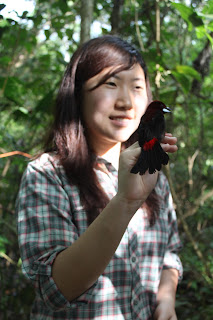 |
We learned how things work at Cocobolo and how to be safe
and enjoy being in the rain forest.
Here, our boots are on the steps of Base
Camp,
where we gathered to eat, work and relax. |
 |
| Miss Lynch took a lot of pictures |
 |
We were treated to wonderful food, cooked by Eunice
in a very efficient kitchen with minimal electricity.
One of our favorite meals was
tamale stuffed with ground corn and chicken.
|
 |
At night, the frogs came out. Plate-sized frogs were found
under our sleeping tents.
|
 |
| Everyone learned how to take birds out of the nets to collect the data at base camp. |
 |
No one can argue: Miss Doss loves her work!
|
 |
| Everyone worked together to get all the bird data collected. |
 |
| No one can catch reptiles like Andrew |
 |
Vicky’s first bird capture was a crimson back Tanager
|
 |
Will releases a bay Wren after collecting its data
|
 |
We collected reptiles and amphibians,
and used the white pop
up box for taking pictures of them.
Some of them were swabbed to check for the chytrid
fungus.
|
 |
Joel and Sabina brought a green vine snake back to base camp
for us to inspect.
|











No comments:
Post a Comment